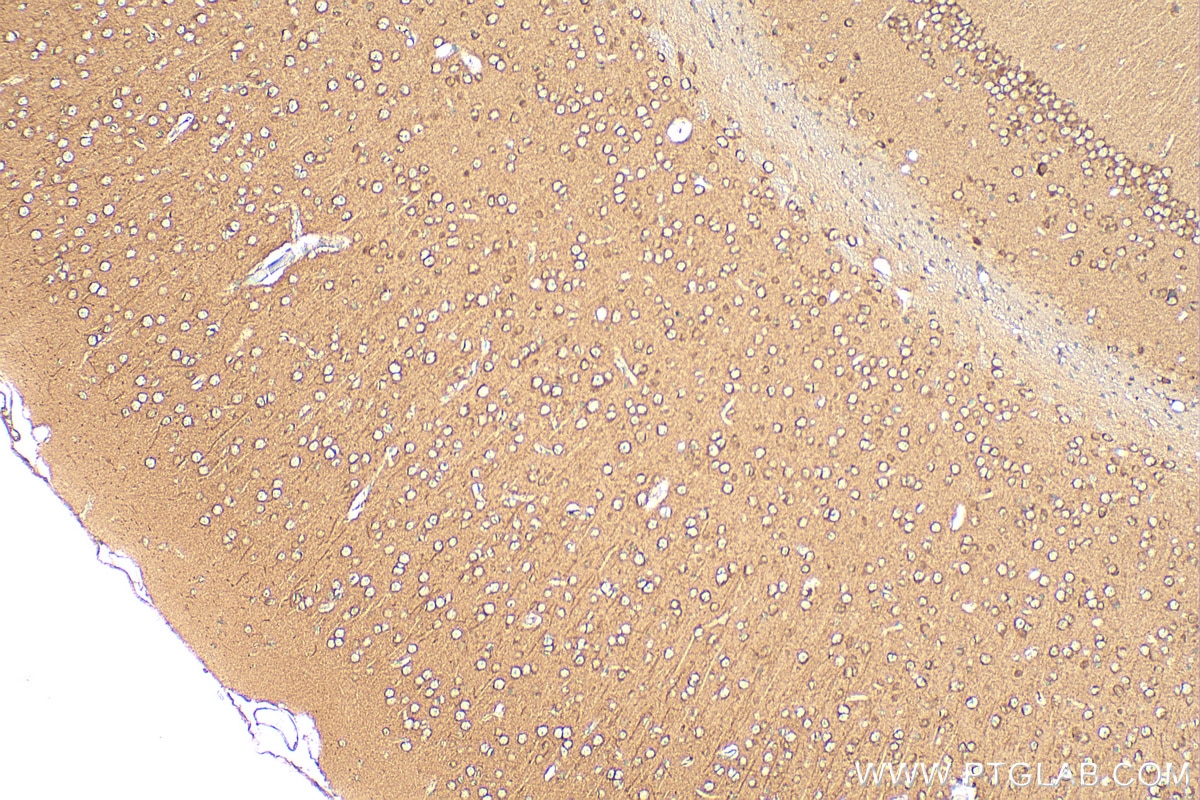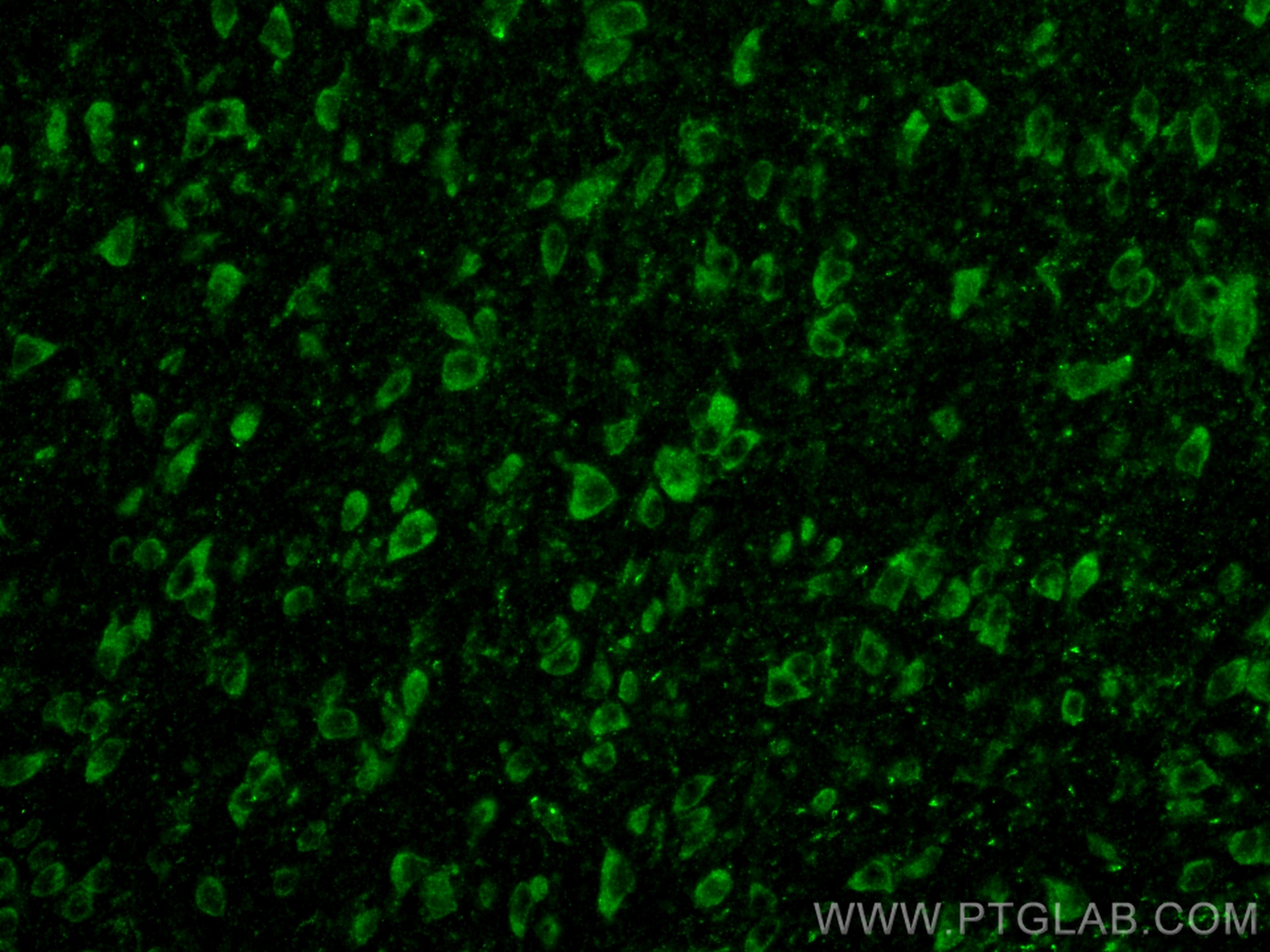Anticorps Polyclonal de lapin anti-DLL3
DLL3 Polyclonal Antibody for WB, IHC, IF-P, ELISA
Hôte / Isotype
Lapin / IgG
Réactivité testée
Humain, rat, souris
Applications
WB, IHC, IF-P, ELISA
Conjugaison
Non conjugué
N° de cat : 25535-1-AP
Synonymes
Galerie de données de validation
Applications testées
| Résultats positifs en WB | tissu hépatique de souris, tissu cérébral de rat |
| Résultats positifs en IHC | tissu hépatique humain, tissu cérébral de souris il est suggéré de démasquer l'antigène avec un tampon de TE buffer pH 9.0; (*) À défaut, 'le démasquage de l'antigène peut être 'effectué avec un tampon citrate pH 6,0. |
| Résultats positifs en IF-P | tissu cérébral de souris, |
Dilution recommandée
| Application | Dilution |
|---|---|
| Western Blot (WB) | WB : 1:500-1:3000 |
| Immunohistochimie (IHC) | IHC : 1:50-1:500 |
| Immunofluorescence (IF)-P | IF-P : 1:50-1:500 |
| It is recommended that this reagent should be titrated in each testing system to obtain optimal results. | |
| Sample-dependent, check data in validation data gallery | |
Applications publiées
| WB | See 1 publications below |
| IHC | See 2 publications below |
Informations sur le produit
25535-1-AP cible DLL3 dans les applications de WB, IHC, IF-P, ELISA et montre une réactivité avec des échantillons Humain, rat, souris
| Réactivité | Humain, rat, souris |
| Réactivité citée | Humain |
| Hôte / Isotype | Lapin / IgG |
| Clonalité | Polyclonal |
| Type | Anticorps |
| Immunogène | DLL3 Protéine recombinante Ag21965 |
| Nom complet | delta-like 3 (Drosophila) |
| Masse moléculaire calculée | 65 kDa |
| Poids moléculaire observé | 65-70 kDa |
| Numéro d’acquisition GenBank | BC000218 |
| Symbole du gène | DLL3 |
| Identification du gène (NCBI) | 10683 |
| Conjugaison | Non conjugué |
| Forme | Liquide |
| Méthode de purification | Purification par affinité contre l'antigène |
| Tampon de stockage | PBS with 0.02% sodium azide and 50% glycerol |
| Conditions de stockage | Stocker à -20°C. Stable pendant un an après l'expédition. L'aliquotage n'est pas nécessaire pour le stockage à -20oC Les 20ul contiennent 0,1% de BSA. |
Informations générales
The Delta-Notch pathway is an evolutionarily conserved signaling pathway which controls a broad range of developmental processes including cell fate determination, terminal differentiation and proliferation (PMID: 22353464). In mammals, four Notch receptors (NOTCH1-4) and five activating canonical ligands (JAGGED1, JAGGED2, DLL1, DLL3 and DLL4) have been described (PMID: 22353464). DLL3 is an inhibitory ligand of the Notch signaling pathway that is predominantly localizes to the Golgi apparatus (PMID: 17664336) in normal condition. Normal tissue expression of DLL3 is highest in fetal brain, and DLL3 plays a key role in somitogenesis in the paraxial mesoderm (PMID: 26311731). It has been reported that DLL3 is expressed on the surface of tumor cells of small cell lung cancer (SCLC) and high-grade neuroendocrine carcinomas (LCNEC) and has emerged as a novel therapeutic target (PMID: 26311731; 28487384).
Protocole
| Product Specific Protocols | |
|---|---|
| WB protocol for DLL3 antibody 25535-1-AP | Download protocol |
| IHC protocol for DLL3 antibody 25535-1-AP | Download protocol |
| IF protocol for DLL3 antibody 25535-1-AP | Download protocol |
| Standard Protocols | |
|---|---|
| Click here to view our Standard Protocols |
Publications
| Species | Application | Title |
|---|---|---|
Transl Oncol High expression of DLL3 is associated with a poor prognosis and immune infiltration in invasive breast cancer patients. | ||
Technol Cancer Res Treat Investigation of Candidate Genes and Pathways in Basal/TNBC Patients by Integrated Analysis. | ||
J Immunother Cancer Combined DLL3-targeted bispecific antibody with PD-1 inhibition is efficient to suppress small cell lung cancer growth. |








